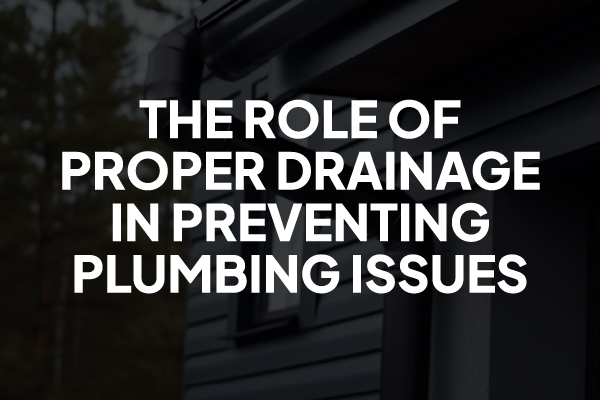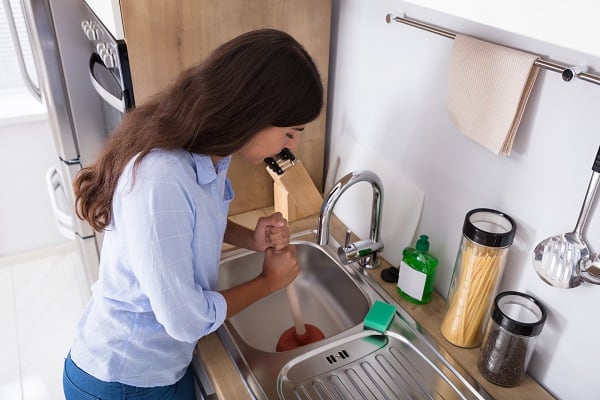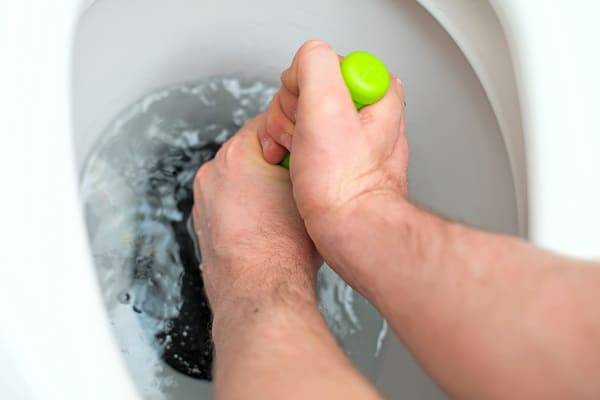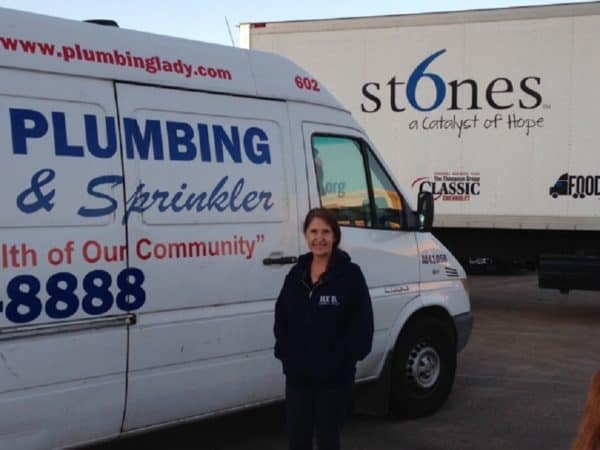
Table of contents
Drains exist everywhere in and out of your home. Every time you turn on a sink, run water in a shower, or experience rain, you depend on drains to do their job. If your drains encounter problems, it can quickly become a hassle. Blocked drains can cause standing water, which can cause drain dysfunction, damage pipes, and even lead to dangerous mold and mildew growth.
In this blog post, HEB Plumbing & Sprinkler will look at the role effective plumbing drainage plays in preventing problems in your home and landscape. We will cover drains inside and outside the house.
Understanding Drainage Systems

Simply put, a drain takes water away from your home using gravity. Drains are found throughout your house as well as outside it. The drainage system is an integral part of your home’s plumbing. They keep many elements of a home running smoothly and help prevent flooding.
In modern homes, drains are generally divided into foul water drainage and surface water drainage.
- Foul drainage – Foul drainage takes water from places such as your laundry, shower, bathrooms, and sinks out of your property.
- Surface water drainage – Surface water drainage includes water on your property that isn’t related to your home’s plumbing, such as rainwater.
Please note that older properties may have combined foul drainage and surface drainage. However, it is better to keep both systems separate. If stormwater flows into foul drainage, it may result in flooding. If foul water gets into the surface drainage water, it can result in the stream it drains into becoming contaminated.
What Types of Drains Are There?
Drains in and outside of homes work to keep water and waste moving where they need to go. In the following section, you’ll learn about the elements of home and foundation drainage systems.
Parts of a Home Drainage System
The drain-waste-vent, or DWV system, is a network of pipes that drains solid waste and wastewater while also functioning as a vent system so fresh air can enter the drain system.
- Fixture drain – A fixture drain is where the drain pathway, or drain-waste-vent system, begins. The fixture drain often has a stopper or plug.
- Drain trap, aka p-trap – Underneath the fixture drain is the drain trap. Designed for holding standing water, this curved pipe seals the drain system and stops sewer gasses from entering a home.
- Toilet trap – A toilet trap functions similarly to a drain trap. Like a drain trap, a toilet trap prevents sewer gasses from coming into a house by holding water.
- Clothes washer standpipe – Water from a washing machine’s drain pipe travels to the clothes washer standpipe. A clothes washer standpipe is a vertical pipe that drains water into a branch line.
- Branch drain line – A branch drain line is an almost vertical pipe that goes from the traps to the main drain line. Branch drain lines are generally one and a half to two inches in diameter.
- Soil pipe – A soil pipe, or soil vent pipe (SVP), is a vertical pipe whose job is to move sewage or soil to the sewer line.
- Soil stack vent – A vertical pipe that sticks out of the roof of a home, the soil stack vent allows foul vapors and gasses to exit and for pressure release to occur to help soil and water move downwards better. This vent enables the plumbing system to have equal air pressure.
- Sewer line clean-out, a.k.a. main house trap – Used for emergency and routine cleaning, the sewer line clean-out enables plumbers to access the sewer line.
- Main drain line – The main drain line is a large pipe (often four inches in diameter) that generally runs horizontally with a small downward tilt. This pipe takes all the waste from your home to the municipal sewer line or septic field.
- Municipal sewer main – The municipal sewer main marks where your home’s drainage system ends and the municipal sewer system begins.
Foundation Drainage Types
- French drains – A French drain foundation system involves pipes with perforations that are wrapped in landscape fabric and buried in a trench made of gravel. The trench goes around the exterior of a home’s foundation. French drains move excess water in the ground to a sewer or an area away from the home.
- Foundation surface drains – These buried pipes are perforated and wrapped in landscape fabric and go around a foundation. Foundation drains prevent water from seeping into the ground by carrying it away from the house.
- Sloping drains – A sloping drain is a hard surface or dirt slope that guides water away from a home so it doesn’t soak into the ground or create a puddle. It may be made of a hard surface like concrete or dirt.
- Sump drains – A sump drain can be in the interior of a foundation, outside of a foundation, or both. They use a perforated pipe system to guide water to a sump pit, a.k.a. sump basin, where it is pumped out by a sump pump located at the lowest point of the house.
Common Foundation Drainage System Components
- Gutter and downspout systems – Gutter and downspout systems collect water from the roof of a house and guide it down to the ground. Once it’s on the ground, the foundation drain system handles it.
- Perforated pipes and solid pipes – A perforated pipe is a rigid or flexible pipe positioned underground by the home’s foundation. The pipes’ perforations allow water to enter them, so it can be taken to solid pipes. The job of solid pipes is to move water to a sump pump or away from a home.
- Landscape fabric and gravel – Landscape fabric is used to wrap around a perforated pipe to prevent silt from getting into the system and clogging it. The landscape fabric-wrapped pipe is positioned in a trench surrounded by gravel. The gravel helps water flow underground.
- Drainage board – Drainage boards are used in some drainage systems to facilitate underground vertical water flow. A drainage board is a plastic sheet that has protrusions and is attached to the foundation’s exterior.
- Sump basins and trenches – Unless it is a simple sloping drainage system, the trench will go around the foundation of a home and consists of gravel and perforated pipe. A sump system’s pipes drain water into a sump basin or pit. Once there, the water is pumped out by an automatic mechanical pump.
Common Plumbing Problems Caused by Poor Drainage
Poor drainage can cause problems far beyond inconvenience. Plumbing problems caused by poor drainage can be costly, damaging, and even harmful to your health.
If one of your house’s drains becomes clogged or blocked, you’ll want to contact a professional to sort it out ASAP. Slow or blocked drains aren’t just an inconvenience; they can result in a number of problems, as detailed below.
Here are some common plumbing problems that can occur as a result of poor drainage.
Please note that this list is not exhaustive.
An Overflowing Toilet

A potential cause of an overflowing toilet is a blockage in the toilet or sewer line. If a plunger isn’t working or the problem happens frequently, contact a plumber to help.
Growth of Bacteria and Germs
Standing water can be a breeding ground for bacteria and germs. This can result in nasty smells and health hazards.
Growth of Mold and Mildew
Standing water can result in the growth of potentially hazardous mold and mildew. Not only can this be bad for health, but it can also result in unpleasant smells.
Pipe Damage
The accumulation of waste can lead to pipes corroding, which can cause them to leak and even burst. A leaking or burst pipe can cause devastating water damage to your home. This is one of the reasons why taking action is important when you encounter drainage problems in your home’s plumbing system.
The Benefits of Effective Drainage Solutions
Good drainage has several benefits for your home and landscape. The following are some of the ways good drainage can benefit your property.
Protects your Landscape
Proper drainage systems can help protect your landscape. Flooding in your yard can lead to many problems, such as erosion and damage to plants and foundations. Not to mention, standing water can attract bugs like mosquitos.
Foundation Protection
Water entering the ground near your home’s foundation can cause pressure against it. This can lead to foundation damage and water getting into your crawlspace or basement. With proper drainage, you can help protect these parts of your home.
Less Likely to Have Slow Drainage or Clogs
If your drainage system has blockage, you‘ll have slow drainage or even none at all. This can lead to mold, mildew, germs, bacteria, and foul smells. With the right drainage system, using drains appropriately, and utilizing regular professional maintenance, you can help keep your drains working right.
Helps Protect Against Pipe Damage
While it is important to note that pipe damage can occur for different reasons, a well-functioning drain can protect against standing water—a potential cause of pipe damage.
HEB Plumbing & Sprinkler: Your Drainage Experts in Bedford, TX

Dealing with drainage issues? Don’t wait for them to worsen. If you are in northeast Tarrant County or the Arlington Area, contact HEB Plumbing to get your drains working right. We can inspect your drains, determine the nature of the blockage, and clear it out. Next, we’ll inspect the nearby area for damage that could have occurred due to the blockage.
We look forward to being your go-to plumbers in Bedford, Texas.
Contact us to book an appointment.
F.A.Q.s
The following are some common drainage-related questions you may have. Please contact a reputable plumber for further information.
Poor drainage can negatively affect plumbing systems in a variety of ways. The following are some but not all of the effects poor drainage can have on plumbing systems.
-Blocked pipes
-Slow drainage
-Backed up water
-Bad smells
-Toilets that overflow with water
–Mildew and mold growth
-Germ and bacteria growth
-Pipe damage
-Pipes that leak or burst
There are a number of signs that can indicate drainage-related plumbing issues that you’ll want to be on the lookout for. When you are able to catch drainage problems early, you may be able to minimize the damage caused by them. Please note that this list is by no means conclusive.
-Clogged drains
-Gutters overflow
-The smell of sewers
-Gurgling toilets
-Your basement has a water stain
-Walls have deposits and flaking
-Standing water in your lawn
-Inconsistent lawn growth
-Drains are belching or sluggish
-Your attic has mildew
-Your home’s foundation develops cracks
Here are a few ways to improve drainage on your property. For the best results, be sure to work with a reputable professional, as each situation is unique.
Ensure gutters are clean. Look into installing a gutter guard.
Have downspouts professionally extended. A downspout should extend at least six feet from a home.
Have a sump pump installed. Many homes can benefit from a sump pump. Work with a professional to determine if one is right for your home.
Have drains and pipes professionally cleaned. A reputable plumber can get your drains and pipes working like new.
Have a professional clean plumbing vents. If your plumbing vents become obstructed, it can hamper drainage. Given the difficulty of reaching plumbing vents, having a professional clean them is the safest option.
Install a French drain. French drains are a versatile way to help prevent lawns from flooding. Be sure to work with a professional to determine if this is the right option for you.
There are many reasons to select HEB Plumbing and Sprinkler in Bedford, Texas, for your plumbing drainage solutions. For decades, people have trusted us with their plumbing needs. We’ve earned many five-star ratings from satisfied customers and have received multiple awards. We also maintain an A+ rating with the Better Business Bureau.
